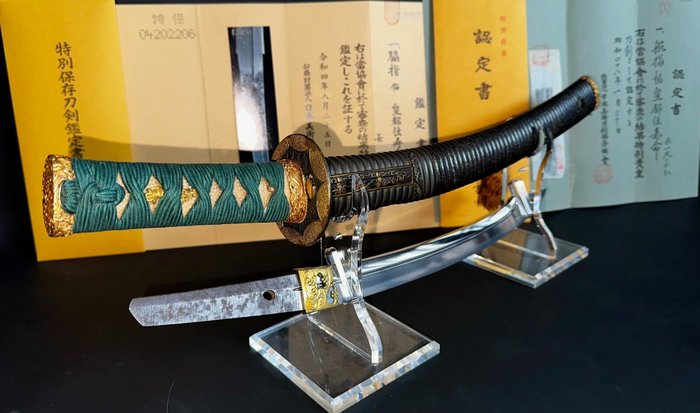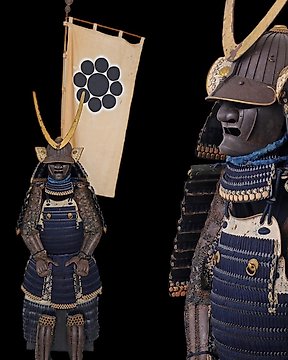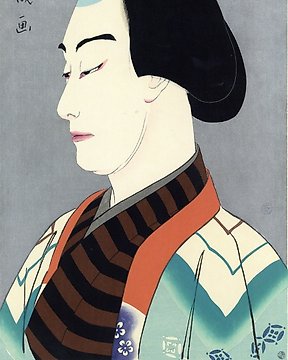Katana (1) - Stahl - Tessuishi Kuniteru - Japan - 1868
Nr. 81608203

Japanischer Samurai Wakizashi, signiert von Jyumyo mit NBTHK Tokubestsu Hozon-Zertifikat - japanische Stimme - Jyumyo - Japan - Ausbildungszeit
Nr. 81608203

Japanischer Samurai Wakizashi, signiert von Jyumyo mit NBTHK Tokubestsu Hozon-Zertifikat - japanische Stimme - Jyumyo - Japan - Ausbildungszeit
Antique Japanese Sword Wakizashi Signed by Jyumyo with NBTHK Tokubestsu Hozon Certificate This knife signed by Kouto Jyu Jyumyo (皇都住寿命) during shin shin to era, (late Edo period: late 18th-mid 19th century) according to NBTHK’s assessment. Kouto is literally translated as a city of the emperor. At the time, the Emperor of Japan lived in Kyoto. Therefore, Kouto Jyu means that he lived in the city of Kyoto when he forged this blade. Kyoto city is located in Yamashiro province. He belonged to the Jumyo School. This knife is rated as a Tokubetsu Hozon Token(特別保存刀剣) published by NBTHK (Nihon Bijutsu Touken Hozon Kyokai: 日本美術刀剣保存協会). This authentication paper was only given to authentic Japanese swords, especially well preserved and of high quality with artistic value. Wakizashi (SHIN SHIN TO) Age Late Edo period: late 18th-mid 19th century Swordsmith Kouto Jyu Jyumyo (皇都住寿命) Certificate NBTHK Tokubetsu Hozon Certificate Location Yamashiro Province (Today’s Kyoto) Blade size Cutting Edge Length: 30.6 cm Curvature: 1.1cm The JYUMYO school has its origins in YAMATO (NARA Pref.) and moved to MINO province in the KAMAKURA period. The tradition persisted for centuries until the end of the EDO period. Their name “JYUMYO” means longevity or longevity. Because the meaning is so hopeful, their swords were valued as celebrated gifts to DAIMYO great families among SAMURAI society. The MINO swordsmith style, also known as MINO-DEN, basically has the TOGARI (Pointed shapes protruding from the Hamon) in a classic straight line and random temper line with some white Utsuri. MINO-DEN originated in YAMATO-DEN in the late KAMAKURA period (1280-1330). It flourished in the MUROMACHI period (1333-1573) and continued until the EDO period (1603-1868). MINO-DEN flourished especially during Sengoku Jidai (Warring State Period) due to the high demand for weapons. And the location of Mino province beat others. Akechi Mitsuhide controlled Mino province and Nobunaga Oda ruled Owari province, and Tokugawa Ieyasu was the lord of Suruga (adjacent areas). Those powerful feudal lords and their vassals were in great demand. Moreover, so many wars took place between Kanto region and Kyoto area. Mino is in the middle, which makes feudal lords feel comfortable ordering swords from MINO-DEN. The knives forged in MINO provinces also had a reputation for their practical design and sharpness. Many feudal lords demanded swords forged in the province of Mino. The tradition of excellent swordsmiths had been passed down to the Edo period, and many members of the Jumyo school also moved to another part of Japan for better opportunities during the Edo period.
Das könnte Ihnen auch gefallen
- 16+
Dieses Objekt wurde vorgestellt in:
So kaufen Sie auf Catawiki
1. Etwas Besonderes entdecken
2. Höchstgebot abgeben
3. Sichere Zahlung durchführen








